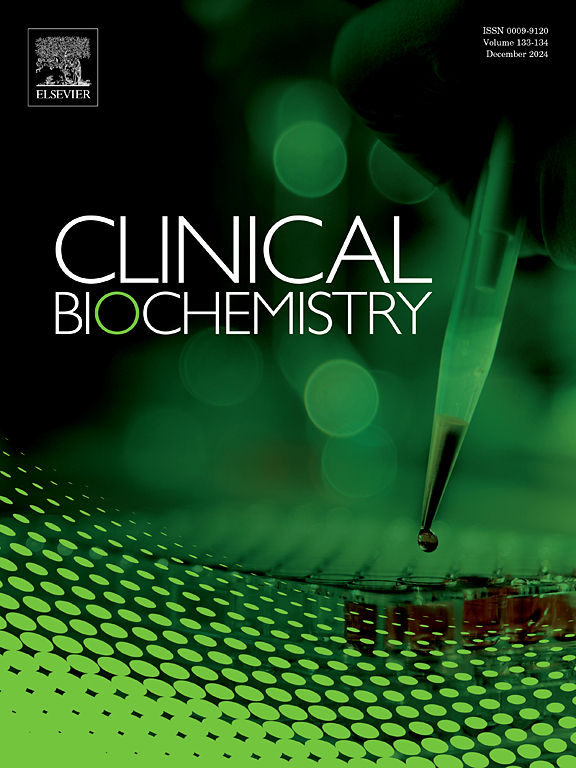丹麦儿科人群血清免疫球蛋白 A、G 和 M 的参考区间
IF 2.1
3区 医学
Q2 MEDICAL LABORATORY TECHNOLOGY
引用次数: 0
摘要
目的确定年龄和性别特异性的血清免疫球蛋白(IgA、IgG和IgM)参考值,并研究免疫球蛋白浓度是否随体重指数标准差评分(BMI SDS)的变化而变化。材料与方法共招募2171名学龄儿童和青少年(中位年龄12.0岁)。计算BMI SDS,通过问卷调查和采血评估健康状况。采用免疫比浊法测定空腹血清IgA、IgG和IgM浓度。根据临床和实验室标准协会(CLSI) EP28-A3c指南生成和划分性别和年龄特异性百分位数。采用多元线性回归模型研究IgA、IgG、IgM和BMI SDS在年龄和性别调整后的相关性。结果IgA的浓度随年龄的增长而增加,但在男孩和女孩之间没有差异。IgG和IgM浓度也检测到年龄依赖性增加,尽管IgG在男孩中比女孩更明显。在所有年龄段,女孩IgG和IgM浓度均高于男孩。IgM浓度与BMI SDS呈负相关,与年龄和性别无关。结论:基于丹麦/北欧高加索人群队列的儿童和青少年,我们生成了年龄和性别特异性的IgA、IgG和IgM参考区间。这些发现可以帮助评估原发性和继发性免疫缺陷和自身免疫性疾病的改变。本文章由计算机程序翻译,如有差异,请以英文原文为准。
Reference intervals for serum immunoglobulin A, G, and M in a Danish paediatric population-based cohort
Objectives
To determine age- and sex-specific reference values for serum immunoglobulins (IgA, IgG, and IgM) in a population-based cohort of 6 to 18 years old Danish children and adolescents and investigate if immunoglobulin concentrations vary with body mass index standard deviation score (BMI SDS).
Materials and methods
A total of 2171 school children and adolescents (median age 12.0 years) were recruited. BMI SDS was calculated, and health status was assessed by questionnaire and blood samples. Fasting serum concentrations of IgA, IgG, and IgM were determined by immunonephelometry.
Sex- and age-specific percentiles were generated and partitioned following the Clinical and Laboratory Standards Institute (CLSI) EP28-A3c guidelines. Multiple linear regression models were used to investigate associations between IgA, IgG, IgM, and BMI SDS adjusted for age and sex.
Results
Concentrations of IgA increased with age but did not differ between boys and girls. An age-dependent increase was also detected for concentrations of IgG and IgM, although for IgG it was more pronounced in boys than girls. Girls had higher concentrations of IgG and IgM than boys at all ages. Concentrations of IgM were inversely associated with BMI SDS independent of age and sex.
Conclusions
We generated age- and sex-specific reference intervals for IgA, IgG, and IgM based on children and adolescents from a Danish/North-European Caucasian population-based cohort. The findings can help evaluate alterations seen in primary and secondary immunodeficiencies and autoimmune diseases.
求助全文
通过发布文献求助,成功后即可免费获取论文全文。
去求助
来源期刊

Clinical biochemistry
医学-医学实验技术
CiteScore
5.10
自引率
0.00%
发文量
151
审稿时长
25 days
期刊介绍:
Clinical Biochemistry publishes articles relating to clinical chemistry, molecular biology and genetics, therapeutic drug monitoring and toxicology, laboratory immunology and laboratory medicine in general, with the focus on analytical and clinical investigation of laboratory tests in humans used for diagnosis, prognosis, treatment and therapy, and monitoring of disease.
 求助内容:
求助内容: 应助结果提醒方式:
应助结果提醒方式:


